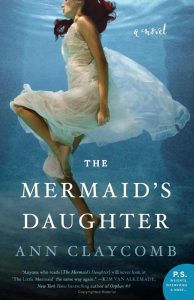
The Sirens Review Squad is made up of Sirens volunteers, who submit short reviews of books (often fantasy literature by women authors) they’ve read and enjoyed. If you’re interested in sending us a review to run on the blog, please email us! Today, we welcome a review from Jae Young Kim on Ann Claycomb’s The Mermaid’s Daughter.
Ann Claycomb’s debut novel, The Mermaid’s Daughter, is a modern-day retelling of Hans Christian Andersen’s “The Little Mermaid,” mixed in with a healthy dose of opera and composition. Kathleen, an opera student at a conservatory, learns that the stabbing pain in her feet and the phantom sensation of her tongue being cut out are not signs of mental illness, but the consequences of a long and dark curse made generations ago. Kathleen is left with two choices—kill herself or kill her lover, Harry.
I love fairy tales. They’re old stories, some coming from oral traditions going as far back as a thousand years, changing over time with every retelling. Each omission, addition and embellishment reflects the teller’s perspective. So when we read a fairy tale retelling, we know, more or less, what the plot will be. It’s the little tweaks in the retelling that make the read worthwhile.
“The Little Mermaid” is one of my favorite fairy tales. Although I was a kid when the Disney animated version came out, I had read Hans Christian Andersen’s original tale before watching the movie, which could not be more different from each other. Disney’s version is a musical with cartoon animal sidekicks, an evil witch that turns into a giant monster, and a happy ending complete with a wedding between the mermaid and prince. Andersen’s tale is dark and bloody, with cut tongues and phantom knives stabbing the mermaid’s feet—and no happy ending. I love both of them, but I was disappointed with Disney’s: it felt too clean and safe, and was totally at odds with the Andersen’s original.
Claycomb does not go the cartoon route with The Mermaid’s Daughter. She does not shy away from the stabbing pains, the cutting of the tongue, and the gruesome trade made by the mermaid. Told in three acts through four viewpoints (Kathleen, Harry, Robin (Kathleen’s father), and the sea witches), the novel is bleak in tone and possibly even darker than Andersen’s fairy tale. Claycomb uses the first act to establish Kathleen’s life, beginning with Kathleen and Harry’s relationship, a great queer take on the usual heterosexual pairings in traditional fairy tales. She also focuses attention on the father-daughter relationship between Robin and Kathleen, and it’s clear that they love each other deeply. Since the novel has a modern-day setting, some time does have to be spent working through disbelief in magic and mermaids. I admit to being impatient that Kathleen didn’t realize the truth of her heritage earlier, but I did have the advantage of knowing she was a mermaid. The sea witches do provide a touch of fantasy as well as the stories of Kathleen’s ancestors, but it may feel dry for those wanting a book that jumps straight into the fantastical elements.
Kathleen also has the beautiful voice of Andersen’s mermaid, making music and opera an integral part of this mermaid’s story. I am a fan of opera and have sung in choirs all my life, so reading about the various singers and the roles and songs they perform was loads of fun. Robin is a famous composer and I loved reading about his composition process, even though I don’t know a thing about songwriting.
The build-up to the reveal of Kathleen’s mermaid secret is long but necessary. Love and music are central to this retelling of “The Little Mermaid.” Once Kathleen learns of her mermaid curse, third act flies by as Robin and Harry help Kathleen resolve it. I won’t spoil the ending but I think it’s clever and fitting for a fairy tale retelling. The book also includes a bonus short story connecting Hans Christian Andersen to Kathleen’s ancestor. It provides some context for final act and is a welcome addition.
I recommend Claycomb’s The Mermaid’s Daughter and look forward to reading her next book.
Jae Young Kim is a born-and-bred New Yorker and a lifelong fan of fairy tales, fantasy and science fiction. She is a non-profit attorney by day and writes when she can, not always by night. The only thing that keeps her up until dawn is a good book.







Connect with the Sirens community
Sign up for the Sirens newsletter